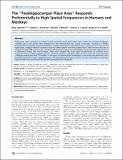The ""Parahippocampal Place Area"" Responds Preferentially to High Spatial Frequencies in Humans and Monkeys
Author(s)
Rajimehr, Reza; Devaney, Kathryn J.; Bilenko, Natalia Y.; Young, Jeremy C.; Tootell, Roger B. H.
DownloadRajimehr-2011-The __Parahippocampa.pdf (1.767Mb)
PUBLISHER_CC
Publisher with Creative Commons License
Creative Commons Attribution
Terms of use
Metadata
Show full item recordAbstract
Defining the exact mechanisms by which the brain processes visual objects and scenes remains an unresolved challenge. Valuable clues to this process have emerged from the demonstration that clusters of neurons (“modules”) in inferior temporal cortex apparently respond selectively to specific categories of visual stimuli, such as places/scenes. However, the higher-order “category-selective” response could also reflect specific lower-level spatial factors. Here we tested this idea in multiple functional MRI experiments, in humans and macaque monkeys, by systematically manipulating the spatial content of geometrical shapes and natural images. These tests revealed that visual spatial discontinuities (as reflected by an increased response to high spatial frequencies) selectively activate a well-known place-selective region of visual cortex (the “parahippocampal place area”) in humans. In macaques, we demonstrate a homologous cortical area, and show that it also responds selectively to higher spatial frequencies. The parahippocampal place area may use such information for detecting object borders and scene details during spatial perception and navigation.
Date issued
2011-04Department
Harvard University--MIT Division of Health Sciences and Technology; McGovern Institute for Brain Research at MITJournal
PLoS Biology
Publisher
Public Library of Science
Citation
Rajimehr, Reza et al. “The ‘Parahippocampal Place Area’ Responds Preferentially to High Spatial Frequencies in Humans and Monkeys.” Ed. David Whitney. PLoS Biology 9 (2011): e1000608.
Version: Final published version
ISSN
1544-9173